June pruning of trees, shrubs and climbers
June is a time to relax and enjoy your garden, but there are still some early flowering shrubs that will need pruning if they are to produce the best possible displays year after year. A few shrubs can also be trained into unusual and attractive standards at this time of the year. June is the ideal month to prune evergreen berberis, Buddleja globosa, winter-flowering dogwoods, broom, deutzia, deciduous elaeagnus, hippophae, magnolia, rosemary, spiraea and lilac, and it’s not too late to complete the pruning jobs for May if you haven’t got round to them yet.
SHRUBS
Berberis (evergreen)
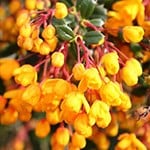 Evergreen berberis including varieties of B. darwinii, B. linearifolia and Berberis x stenophylla need little or no routine pruning while they are growing well. However, you can tidy up plants by trimming them lightly after flowering at this time of the year but you will loose the ornamental berries. Old neglected plants can be improved by removing one or two of the oldest stems to a newer sideshoot lower down or back to near ground level to encourage new growth from the base. This is usually best carried out during the winter months. Evergreen berberis hedges should be trimmed to size and shape now.
Evergreen berberis including varieties of B. darwinii, B. linearifolia and Berberis x stenophylla need little or no routine pruning while they are growing well. However, you can tidy up plants by trimming them lightly after flowering at this time of the year but you will loose the ornamental berries. Old neglected plants can be improved by removing one or two of the oldest stems to a newer sideshoot lower down or back to near ground level to encourage new growth from the base. This is usually best carried out during the winter months. Evergreen berberis hedges should be trimmed to size and shape now.
Buddleja
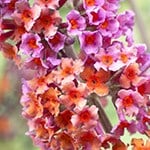 Unlike the butterfly bush (Buddleja davidii), B. globosa and B. alternifolia flower on shoots produced during the previous year, so if you pruned them hard in spring you would loose all of this year’s flowers. For this reason they are best pruned after flowering in early summer. Remove any dead or damaged growth and shorten lop-sided or over-long shoots to balance the overall shape of the shrub. Old and neglected shrubs can be rejuvenated by cutting out one-in-three stems, starting with the oldest. Either cut them back to a sideshoot lower down or remove them completely. You will loose some flowering shoots for next year but the shrub will be the better for it in subsequent years.
Unlike the butterfly bush (Buddleja davidii), B. globosa and B. alternifolia flower on shoots produced during the previous year, so if you pruned them hard in spring you would loose all of this year’s flowers. For this reason they are best pruned after flowering in early summer. Remove any dead or damaged growth and shorten lop-sided or over-long shoots to balance the overall shape of the shrub. Old and neglected shrubs can be rejuvenated by cutting out one-in-three stems, starting with the oldest. Either cut them back to a sideshoot lower down or remove them completely. You will loose some flowering shoots for next year but the shrub will be the better for it in subsequent years.
You can also train B. alternifolia as an attractive and unusual weeping standard. Select the most vigorous stem and tie this to a vertical cane after planting. Cut back most of the other stems, so that about ¾ of the growth is removed. Each year, tie in the new growth of the main stem to the cane and thin out the oldest sideshoots. These will encourage the main stem to thicken and become self-supporting in time. When the main stem reaches the required height, pinch out the growing tip to encourage sideshoots to form. All sideshoots lower down the stem should be removed. The following year, pinch out the sideshoots that form the head of the standard so that they branch and become bushy. In subsequent years, prune the standard during June after flowering by removing dead or damaged stems as well as thinning out congested growth. Then cut back the weeping flowered stems to a sideshoot that hasn’t produced flowers or to a plump bud near the main framework of branches. In this way you will get a succession of flowering stems year after year.
Cornus (winter-flowering dogwood)
 The winter-flowering dogwoods, Cornus mas and Cornus officinalis are also grown for their attractive foliage and colourful fruits. They require little or no pruning other than the removal of dead or damaged stems. The foliage displays of variegated forms can be improved by cutting back one-in-three stems, starting with the oldest. This will encourage vigorous new growth. Old and neglected plants can be rejuvenated in the same way. Cornus mas also lends itself to being trained as a standard (see Buddleja, above).
The winter-flowering dogwoods, Cornus mas and Cornus officinalis are also grown for their attractive foliage and colourful fruits. They require little or no pruning other than the removal of dead or damaged stems. The foliage displays of variegated forms can be improved by cutting back one-in-three stems, starting with the oldest. This will encourage vigorous new growth. Old and neglected plants can be rejuvenated in the same way. Cornus mas also lends itself to being trained as a standard (see Buddleja, above).
Cytisus (broom)
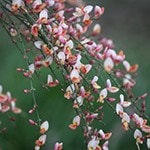 After flowering, varieties of Cytisus scoparius and C. x praecox can be pruned to keep them neat and tidy. If left untrimmed for many years, they will become bare and ugly at the base and produce fewer flowers. Cut back flowered shoots to a sideshoot that hasn’t produced flowers or to a plump bud. Aim to remove at least half of the previous season’s growth. Do not cut back into old wood because cytisus are reluctant to re-sprout. Old and neglected shrubs do not respond to severe pruning and so are best replaced.
After flowering, varieties of Cytisus scoparius and C. x praecox can be pruned to keep them neat and tidy. If left untrimmed for many years, they will become bare and ugly at the base and produce fewer flowers. Cut back flowered shoots to a sideshoot that hasn’t produced flowers or to a plump bud. Aim to remove at least half of the previous season’s growth. Do not cut back into old wood because cytisus are reluctant to re-sprout. Old and neglected shrubs do not respond to severe pruning and so are best replaced.
Deutzia
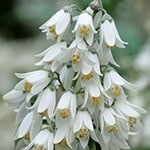 Maintain the flowering performance of deutzias by pruning each year immediately after flowering. After planting, lightly trim to encourage bushy growth. In subsequent years cut back flowered stems to a sideshoot that hasn’t produced flowers or to a plump bud. Congested plants can have one-in-three stems removed, starting with the oldest. Old and neglected plants can be rejuvenated in the same way.
Maintain the flowering performance of deutzias by pruning each year immediately after flowering. After planting, lightly trim to encourage bushy growth. In subsequent years cut back flowered stems to a sideshoot that hasn’t produced flowers or to a plump bud. Congested plants can have one-in-three stems removed, starting with the oldest. Old and neglected plants can be rejuvenated in the same way.
Elaeagnus (oleaster)
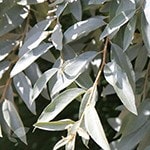 Deciduous Elaeagnus angustifolia and E. umbellata varieties require little routine pruning other than the removal of dead or damaged stems. Old and neglected plants can be rejuvenated by cutting back one-in-three stems, starting with the oldest. Hedges can also be given a light trim at this time of the year and again in September.
Deciduous Elaeagnus angustifolia and E. umbellata varieties require little routine pruning other than the removal of dead or damaged stems. Old and neglected plants can be rejuvenated by cutting back one-in-three stems, starting with the oldest. Hedges can also be given a light trim at this time of the year and again in September.
Hippophae
The problem when pruning hippophae is identifying the dead stems from the live. That’s why it’s a good idea to wait until this month when you can clearly tell the difference, but wear eye-protection and gloves to protect yourself from thorny stems. Although little or no routine pruning is necessary, if the shrub is well established and growing well, you may need to thin out overcrowded stems in the centre of the shrub. Hippophae is also prone to suckering, but unlike other suckering shrubs won’t throw up even more vigorous suckers if these are pruned off at ground level. Old and neglected plants can be rejuvenated by pruning to about 10cm during early spring. Alternatively, if you find this too drastic, cut back one-in-three stems to near ground level, starting with the oldest.
Magnolia
 Varieties of Magnolia x soulangeana, M. liliflora, and M. stellata can suffer from die back when pruned during the dormant season and are prone to bleeding when they are pruned in spring. They are best left until early summer when in full leaf. The branches of magnolias are brittle and prone to storm damage, so remove any dead or damaged stems. Small specimens are worth deadheading as flowers fade to tidy the shrub and so that the plants put their energies into flower bud production for next year rather than seed production this. Old and neglected specimens can be rejuvenated by more severe pruning – removing two or three of the oldest branches - but take care to maintain a balanced, open canopy of branches. Heavy pruning can cause the shrub to stop flowering for a few years while it recovers.
Varieties of Magnolia x soulangeana, M. liliflora, and M. stellata can suffer from die back when pruned during the dormant season and are prone to bleeding when they are pruned in spring. They are best left until early summer when in full leaf. The branches of magnolias are brittle and prone to storm damage, so remove any dead or damaged stems. Small specimens are worth deadheading as flowers fade to tidy the shrub and so that the plants put their energies into flower bud production for next year rather than seed production this. Old and neglected specimens can be rejuvenated by more severe pruning – removing two or three of the oldest branches - but take care to maintain a balanced, open canopy of branches. Heavy pruning can cause the shrub to stop flowering for a few years while it recovers.
Rosmarinus (rosemary)
 If left untrimmed for many years, rosemary will become bare and ugly at the base and produce fewer flowers. After the main period of flowering is over, remove any dead or damaged growth and shorten lop-sided or over-long shoots to balance the overall shape of the shrub - cutting back to a sideshoot lower down. However, rosemary is reluctant to produce new shoots from woody stems so avoid pruning back into old wood. Old and neglected shrubs that are well clothed in foliage near the base can have all stems cut back by about half to sideshoots lower down on each stem, otherwise they do not respond to severe pruning and so are best replaced.
If left untrimmed for many years, rosemary will become bare and ugly at the base and produce fewer flowers. After the main period of flowering is over, remove any dead or damaged growth and shorten lop-sided or over-long shoots to balance the overall shape of the shrub - cutting back to a sideshoot lower down. However, rosemary is reluctant to produce new shoots from woody stems so avoid pruning back into old wood. Old and neglected shrubs that are well clothed in foliage near the base can have all stems cut back by about half to sideshoots lower down on each stem, otherwise they do not respond to severe pruning and so are best replaced.
Spiraea (bridal wreath)
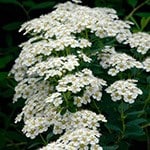 Spiraea ‘Arguta’ and S. veitchii should be pruned immediately after flowering to maintain flowering performance. After planting, lightly trim to encourage bushy growth. In subsequent years cut back flowered stems to a sideshoot that hasn’t produced flowers or to a plump bud. Congested plants can have one-in-three stems removed, starting with the oldest. Old and neglected plants can be rejuvenated by cutting back to near ground level, but the flowering display will be reduced for a few years. Alternatively, cut back one-in-three stems each year for three years, starting with the oldest. Hedges can also be trimmed immediately after flowering.
Spiraea ‘Arguta’ and S. veitchii should be pruned immediately after flowering to maintain flowering performance. After planting, lightly trim to encourage bushy growth. In subsequent years cut back flowered stems to a sideshoot that hasn’t produced flowers or to a plump bud. Congested plants can have one-in-three stems removed, starting with the oldest. Old and neglected plants can be rejuvenated by cutting back to near ground level, but the flowering display will be reduced for a few years. Alternatively, cut back one-in-three stems each year for three years, starting with the oldest. Hedges can also be trimmed immediately after flowering.
Syringa (common lilac)
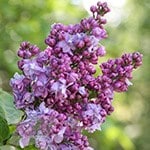 After planting, trim lightly to produce a balanced shape. Where practical, deadhead lilacs as the flowers fade, taking care not to remove the new shoots that lie just underneath that will carry the following year’s flowers. Use a pair of secateurs and make a clean cut right at the base of the faded flower spike. Remove suckers by cutting them off cleanly from the roots or main stem. Old and neglected plants can be renovated by cutting all stems to a stubby framework about 45cm (18in) from the ground, or if this is too drastic for you, remove one-in-three of the oldest stems each year for three years until the whole shrub has been rejuvenated. Syringa meyeri also lends itself to being trained as a standard (see Buddleja, above).
After planting, trim lightly to produce a balanced shape. Where practical, deadhead lilacs as the flowers fade, taking care not to remove the new shoots that lie just underneath that will carry the following year’s flowers. Use a pair of secateurs and make a clean cut right at the base of the faded flower spike. Remove suckers by cutting them off cleanly from the roots or main stem. Old and neglected plants can be renovated by cutting all stems to a stubby framework about 45cm (18in) from the ground, or if this is too drastic for you, remove one-in-three of the oldest stems each year for three years until the whole shrub has been rejuvenated. Syringa meyeri also lends itself to being trained as a standard (see Buddleja, above).
TREES
Grevillea (spider flower)
Grevillea robusta is a half-hardy tree sometimes grown as a short-lived, foliage house plant in cool climates. It will not produce its characteristic spidery flowers but the feathery leaves are attractive. Little pruning is necessary apart from the removal of dead or damaged stems. It can also be trained as an unusual wall shrub against a south-facing, sheltered vertical surface, but will need winter protection. In this case, train as a cordon tying in branches to horizontal wires spaced about 45cm (18in) apart up the wall. During June each year, tie in selected new stems at a 45 degree angle each side of the main stem and lower those tied in the previous year to 90 degrees, so that they are in line with the supporting wires. Repeat this process until all the tiers of the main framework are complete, then pinch out the growing tip of each branch when it reaches the edge of the support. Thereafter, shorten any side-shoots to two or three leaves.
Paulownia (foxglove tree)
If grown as a specimen tree, Paulownia tomentosa needs little pruning other than the removal of dead or damaged growth in early summer. Create a clear stem on well-established trees by removing sideshoots when young. However, they also respond well to severe pruning and so can be cut back hard each spring to encourage vigorous new shoots and large, attractive leaves that will add a tropical feel to beds and borders. During March, cut back all shoots produced the previous year to near ground level or a short stubby framework. Paulownia can also be grown as a pollarded tree, where two-year-old stems are cut back each year to within 2cm (1/2in) of the main stem – creating a lollipop-shaped tree with lush leaves. However, if you prune in this way you will have to sacrifice getting any flowers.
Next month: Buxus, Carpenteria, Ceanothus, Cytisus battandieri, Escallonia, Euphorbia, Fremontodendron, Hebe, Helianthemum, Kolkwitzia,, Robinia, Rubus, Rosa, Sophora, Tamarix, Weigela, Wisteria and many more.













